Perfect Laboratory Management System
The Perfect Laboratory Manager is a feature-rich, offline-capable Laboratory Information Management System (LIMS) tailored to meet the demanding needs of modern diagnostic laboratories, especially in regions like Africa where internet connectivity may be intermittent. The system combines robust automation with practical design, enabling labs to manage patient workflows, lab tests, specimens, billing, and reporting with precision and efficiency. Whether you are a small private clinic or a multi-site diagnostic chain, the system scales effortlessly and supports integration with outpatient, inpatient, and ward systems.
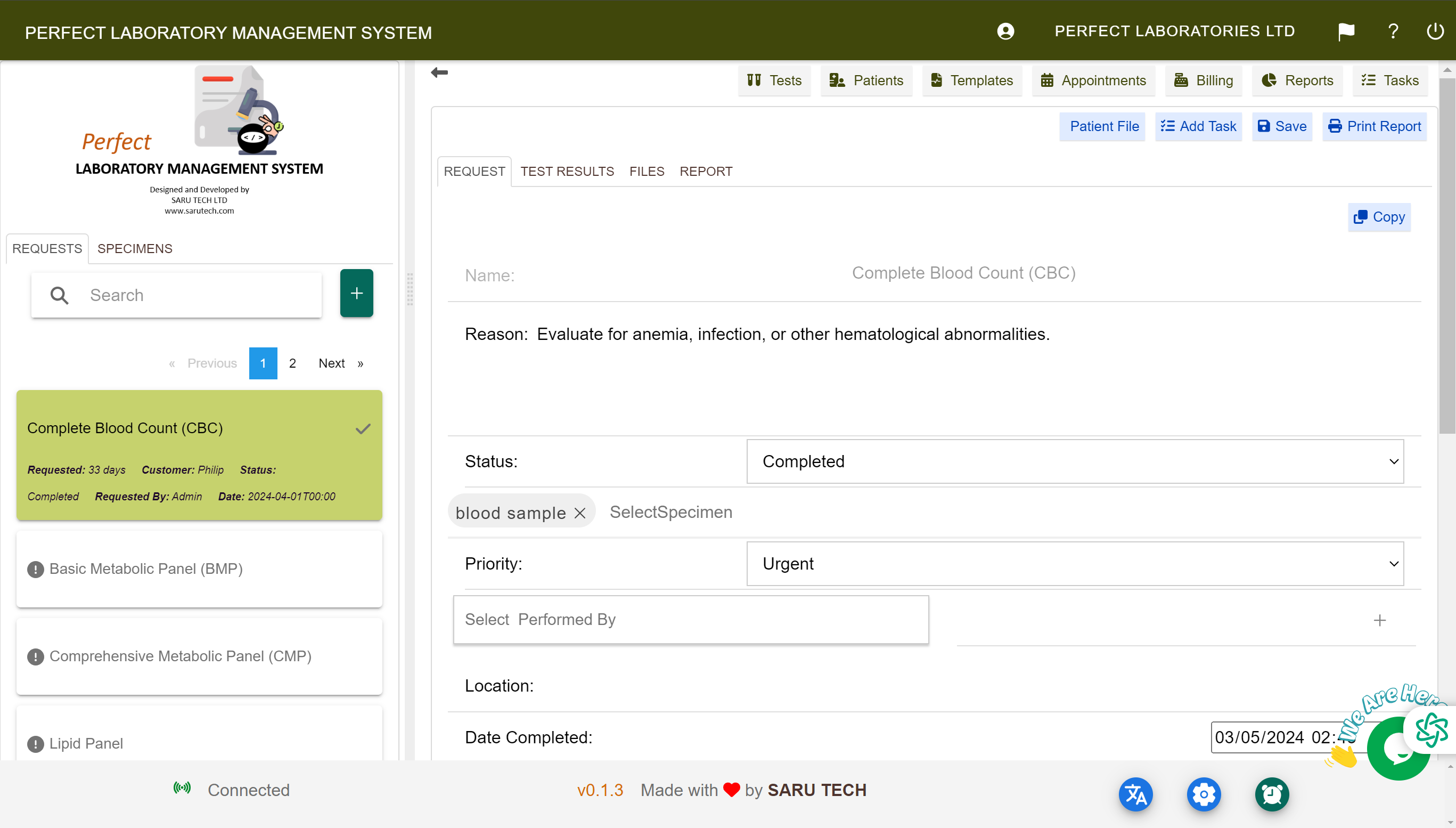
Key Features of the Perfect Laboratory Manager
Offline Mode with Automatic Synchronization
One of the most powerful features of the system is its ability to function entirely offline without compromising functionality. Laboratories can continue working uninterrupted even when there is no internet access—recording samples, entering results, and generating reports. Once an internet connection becomes available, the system automatically synchronizes with the cloud in the background. This makes it ideal for labs in rural, semi-urban, or bandwidth-limited environments across Africa. Whether hosted on-premise or in the cloud, users can be confident that data remains consistent and protected.
Specimen Collection and Reception Workflows
The system includes dedicated modules for both specimen collection and specimen reception, supporting a wide range of collection scenarios. Nurses and collection staff use the Specimen Collection page to record and label samples at the point of care, printing barcodes for each tube. Each sample is tracked from the moment it is taken—whether collected at the clinic, hospital ward, or by the patient at home. Lab staff then receive these samples through the Specimen Reception interface, verifying them against expected orders. This separation of roles ensures proper handoff, reduces errors, and enforces accountability.
For outsourced or home-delivered samples, the reception module includes a checklist to verify sample integrity (e.g., clotting, hemolysis, mislabeling) and automatically logs the receiving staff’s name, timestamp, and any exceptions. Each specimen moves through a series of traceable states such as "Specimen Taken", "Specimen Received", or "Specimen Outsourced", allowing full chain-of-custody tracking throughout its lifecycle.
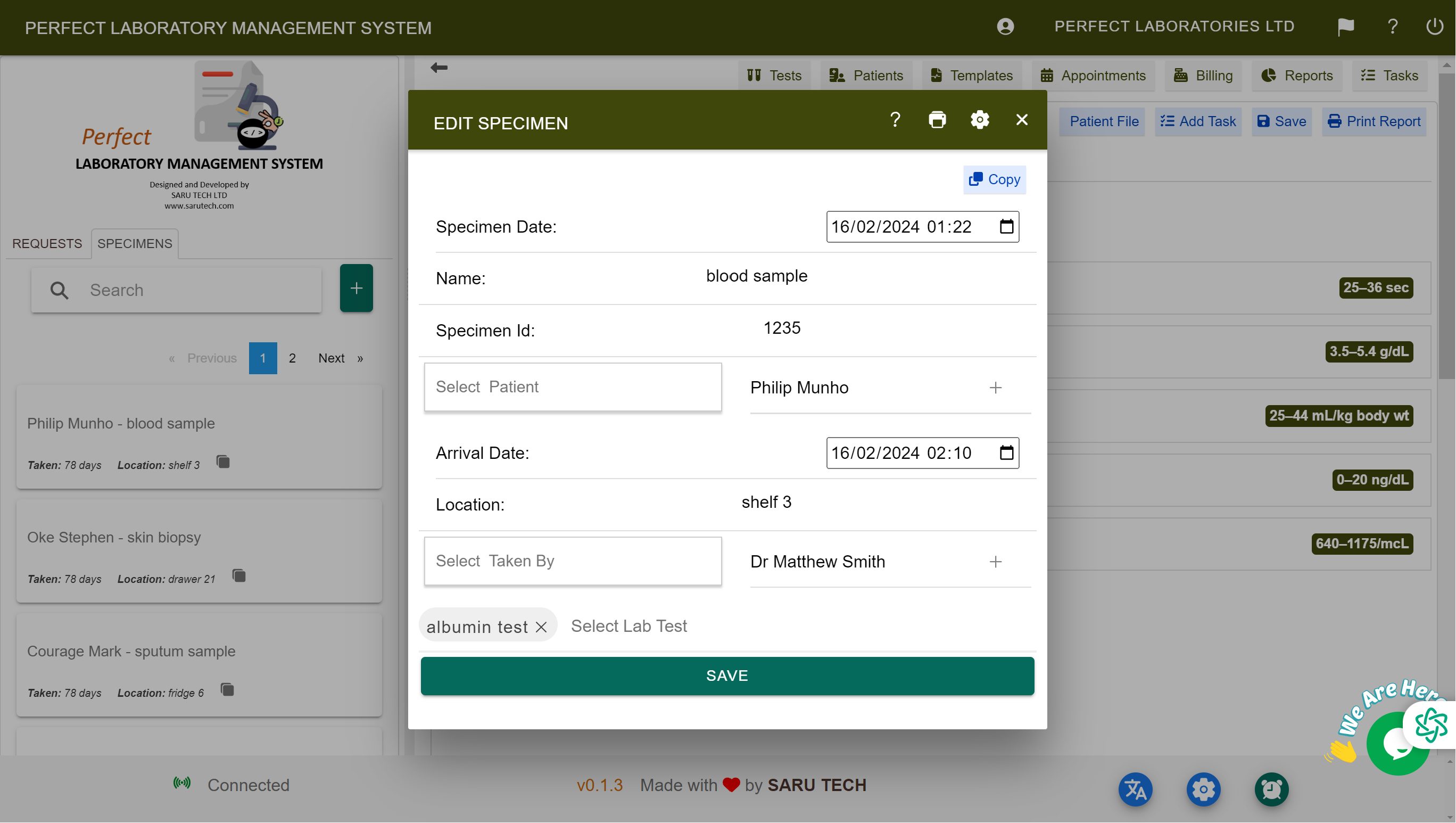
Over 300 Prebuilt Lab Tests and Diagnostic Panels
Perfect Laboratory Manager comes preloaded with a comprehensive library of over 300 commonly performed lab tests across hematology, chemistry, microbiology, immunology, and more. These include individual tests like Glucose, Creatinine, Hemoglobin, and ALT, as well as multi-test panels such as the Complete Blood Count (CBC), Comprehensive Metabolic Panel (CMP), and Liver Function Panel. Each test and panel is preconfigured with normal reference ranges in both SI units (e.g., mmol/L) and conventional units (e.g., mg/dL), making it easier for labs to comply with local or international standards.
Test results are automatically validated against reference ranges, and any abnormal values are visually flagged for the attention of the technician or pathologist. This reduces oversight, improves diagnostic accuracy, and enhances the quality of reports delivered to patients and referring doctors. The modular panel design also saves time during test selection and result entry.
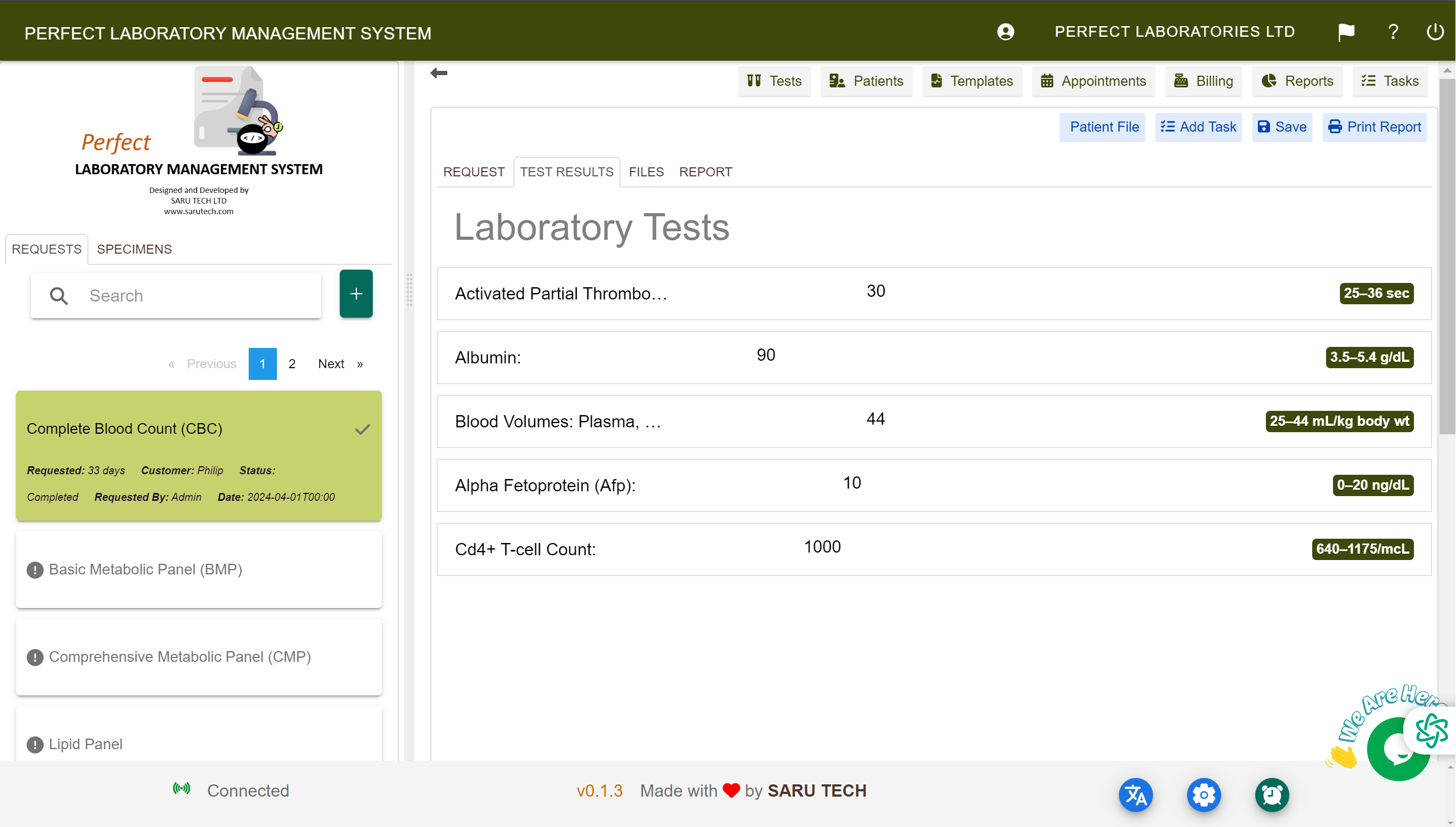

Prebuilt Report Templates and Automatic Generation
Generating professional lab reports is fast and effortless with Perfect Laboratory Manager. The system includes a range of prebuilt, standardized report templates tailored for different types of tests and panels. These templates are automatically populated with patient details, test results, reference ranges, and result interpretations. Reports are styled to meet medical presentation standards and can be digitally signed by authorized personnel.
Laboratories can export reports as PDF files, print them on branded letterheads, or send them directly to patients and referrers via email or integrated messaging. This not only ensures consistency across reports but also dramatically reduces turnaround time by eliminating repetitive manual formatting.
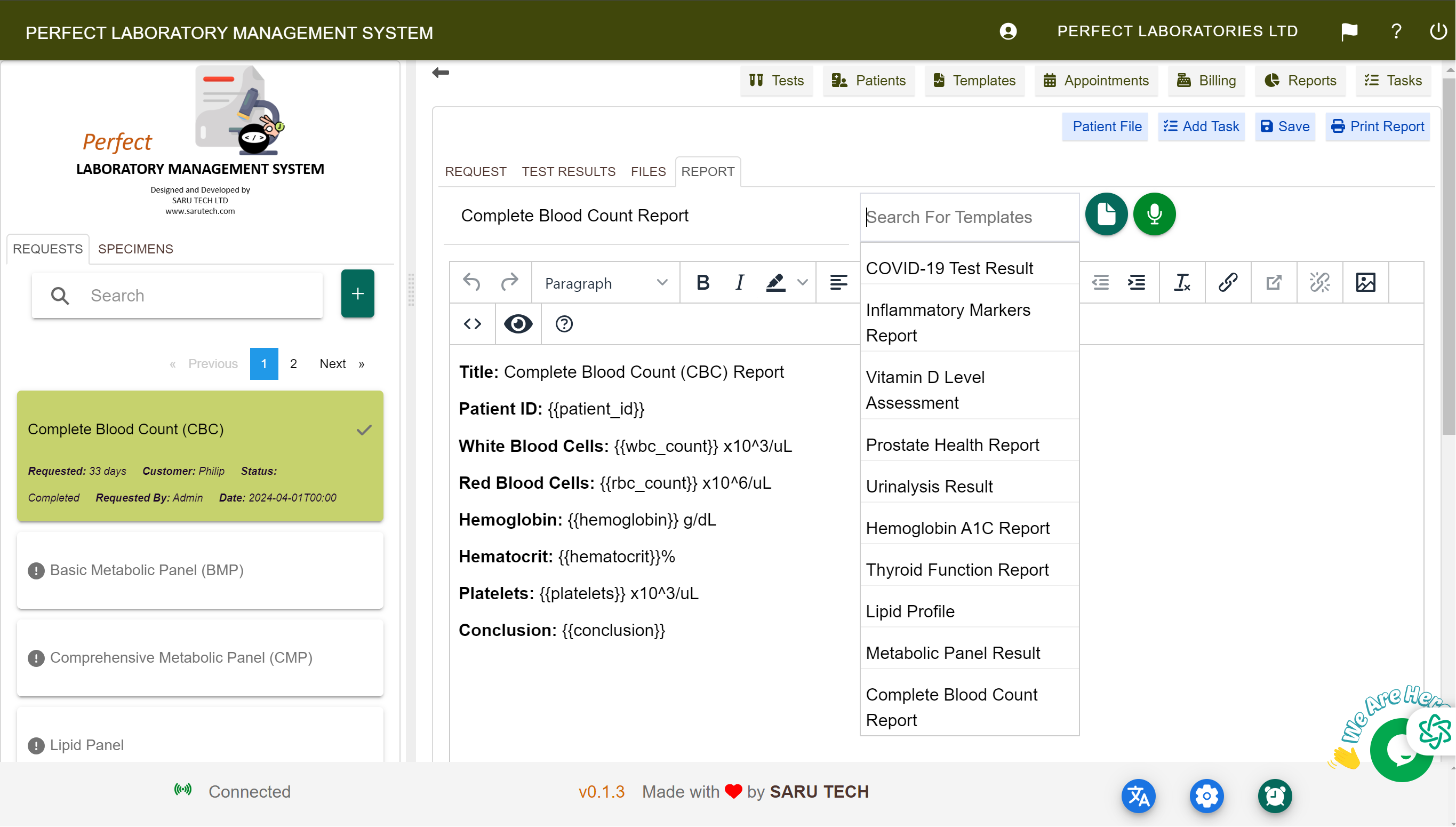
Customisable Workflow Stages with Full Timeline Logging
Each lab order progresses through a detailed and fully customisable workflow with clearly defined stages. These stages include but are not limited to: "Test Ordered", "Specimen Taken", "Specimen Received", "Specimen Outsourced", "Sent to Machine", "Result Entered", "Result Checked", "Result Rejected", "Result Approved", "Completed", and "Cancelled". Labs can define their own stages or modify existing ones to align with internal protocols and regulatory requirements.
Every action taken on a test order—such as sample receipt, result entry, or approval—is logged to a timeline. This audit trail captures the user, timestamp, and action performed, providing full traceability and accountability throughout the testing process. The timeline is especially helpful during audits, dispute resolution, and quality assurance activities.

Result Entry via Manual, Machine, or Outsourced Channels
Laboratories can enter results using several methods to fit their infrastructure and workflow needs. Technicians may enter results manually for visual assessments or tests not handled by automated analyzers. Where machines are available, the system supports integration with laboratory equipment using HL7, ASTM, or custom APIs. This enables automatic transfer of results from devices to the patient record, reducing errors and improving efficiency.
In cases where tests are outsourced to third-party labs, results can be entered upon receipt of paper or digital reports. Outsourced test results are tracked under specific statuses like "Outsourced Received" or "Result Entered", and can be reported separately if needed for invoicing and reconciliation. The result entry interface is user-friendly and intelligent, showing reference ranges and flagging abnormalities in real-time.
Technician Review, Doctor Validation, and Historical Comparison
Once results are entered, lab technicians review them for accuracy. If accepted, the status updates to "Result Checked" and is forwarded to a doctor or pathologist for final validation. If a result appears questionable or is rejected, the technician can re-initiate the test or flag it for new specimen collection. Doctors validate the result by reviewing it in context—ensuring medical interpretation aligns with clinical findings.
In addition, the system enables historical result comparison. For any patient test, users can quickly compare the current result with previous records to detect trends, track chronic conditions, or measure treatment progress. This feature is crucial for high-value cases such as diabetes management, kidney monitoring, and infectious disease tracking.
Inventory and Consumables Management
The Perfect Laboratory Manager includes a full-featured inventory management module that tracks laboratory reagents, consumables, and supplies from purchase through usage and disposal. Each test request can be linked to consumables dispensed—whether syringes, vials, test kits, or gloves—allowing items to be automatically deducted from stock and optionally billed to the patient or included as part of insurance charges. Dispensing is tightly integrated with test requests, ensuring usage is traceable and auditable for every sample processed.
Lab staff can also dispense consumables in sub-units (e.g., milliliters, strips, or pieces) rather than whole packs, with intelligent conversion between unit and sub-unit tracking. Inventory can be stocked based on purchase orders, with expiry dates recorded per batch and alerts generated for soon-to-expire items. Auditing tools allow staff to perform stock reconciliations and view transaction logs for each item to detect variances or wastage.
The system also supports borrowing and returning items between departments or lab sections. Borrowed items are tracked until returned or written off, improving collaboration while maintaining accountability. All actions—stocking, dispensing, transferring, borrowing, returning—are fully logged with user IDs, timestamps, and action types to ensure a complete audit trail.
Procurement workflows allow finance or admin teams to manage suppliers, generate purchase orders, and receive goods directly into stock. Reports are available for low-stock alerts, expiry tracking, top-used items, and monthly usage summaries, giving lab managers real-time insight into operational efficiency and consumption patterns.
Billing System with Insurance and CPT Code Support
The Perfect Laboratory Manager includes a comprehensive billing system designed to handle a wide variety of payment scenarios including private patients, insured clients, and institutional billing. The system supports the use of standardized CPT codes for lab procedures, enabling seamless financial reconciliation with insurance providers and government reimbursement programs. Invoices are automatically generated based on the selected tests and any applied discounts, packages, or coverage.
Insurance billing is deeply integrated, allowing labs to configure multiple insurance providers per patient, specify coverage percentages, and define policy start and end dates. When an insured patient is processed, the system automatically applies the coverage rules and splits the invoice accordingly. Detailed billing reports and outsourced test summaries make it easy to reconcile with third parties and manage pending payments.
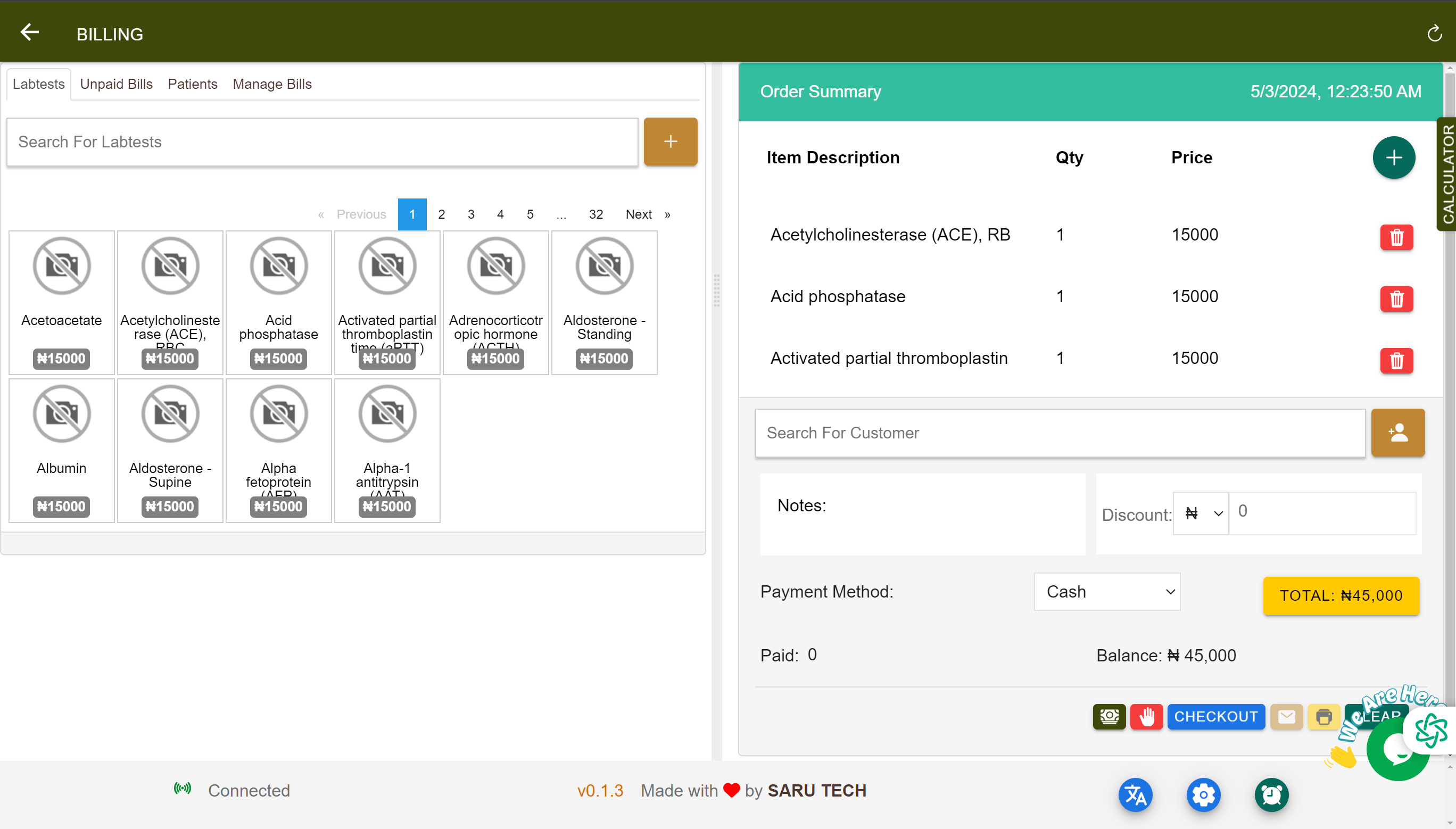
Dedicated Insurance Billing Reconciliation
Managing third-party billing is often complex, particularly when coordinating with multiple insurers or outsourced laboratories. The Perfect Laboratory Manager provides a dedicated Insurance Reconciliation Page that empowers finance teams to manage this process with precision. Finance staff can record and manage **deposit payments**, select specific **outstanding bills to reconcile**, and apply payments partially or in full based on insurer remittances.
The system maintains a **detailed payment history** for every bill, including amounts paid, payment method, date, and the staff responsible. This ensures transparency and provides a full audit trail for every financial transaction. By consolidating all billing, deposits, insurance coverage, and reconciliation workflows in one interface, labs can reduce discrepancies, improve recovery rates, and maintain better financial oversight.
Patient Portal with Appointments, Results, and Online Payments
The patient portal offers an intuitive, mobile-friendly interface where patients can manage their interaction with the lab. Patients can log in securely to view their test history, check current test status, and download reports. They can also compare past and current results for individual tests, which is especially useful for tracking conditions over time.
Appointment booking is built-in: lab technicians can define their availability and break periods, and patients can choose suitable time slots. The portal also supports pre-appointment forms, streamlining registration and saving time at the lab. Payment is convenient and secure, with integration to **PayPal** and **Paystack**, the latter being widely adopted across Nigeria, Ghana, and other African countries.
Referrer Portal for Doctors and Partner Clinics
Doctors and external clinics can use the referrer portal to access test results of their referred patients. The portal supports real-time updates on test progress, instant download of lab reports in PDF format, and direct delivery of critical (panic) results via SMS, email, or call notification. Referrers are also linked to patient invoices for accurate revenue sharing and reconciliation where applicable.
This collaborative approach ensures that referring physicians remain informed, engaged, and confident in the lab’s performance, while also streamlining communication and reducing administrative follow-up.
Integration with Outpatient and Inpatient Hospital Systems
Perfect Laboratory Manager seamlessly integrates with both outpatient (OPD) and inpatient hospital systems, enabling smooth handoff of test requests from the hospital’s clinical departments. Patient demographics, physician orders, and discharge information can be pulled automatically to reduce duplication and ensure data consistency. Test results are pushed back to the originating department, allowing doctors and nurses in wards or outpatient clinics to view completed reports within their existing systems.
This interoperability accelerates patient care, minimizes errors from manual entry, and improves the coordination between departments, especially in larger healthcare facilities or hospital networks.
Document and Image Management
Labs often need to store additional documents such as scanned request forms, consent signatures, microscope images, or external reports. The system provides secure image and document storage linked to patient records and specific test orders. These files can be attached to lab reports or used for internal verification and quality control.
Users can view, upload, and manage files easily, ensuring that all supporting information is stored in one central place and remains accessible to authorized staff.
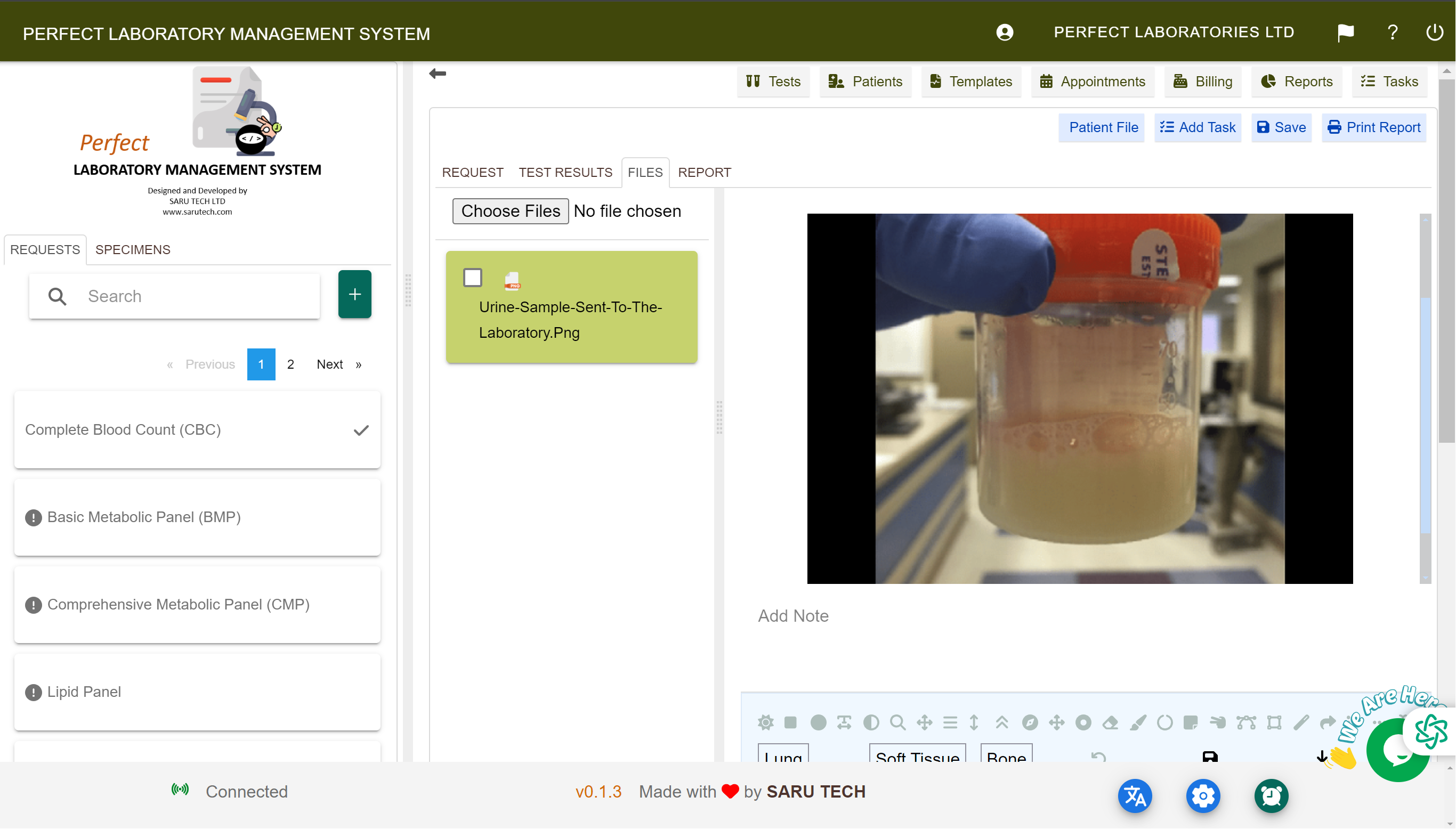
Dynamic Dashboards and Performance Monitoring
The system includes a suite of real-time dashboards and visual analytics tools to help lab managers monitor key performance indicators. Charts display data such as turnaround time (TAT), pending vs. completed tests, specimen rejection rates, and daily sample volumes. These insights enable management to identify workflow bottlenecks, track technician productivity, and implement evidence-based process improvements.
All metrics are filterable by date, branch, technician, or test type, offering both granular and high-level visibility into lab operations. Dashboards empower labs to move from reactive to proactive decision-making and ensure consistent service quality.
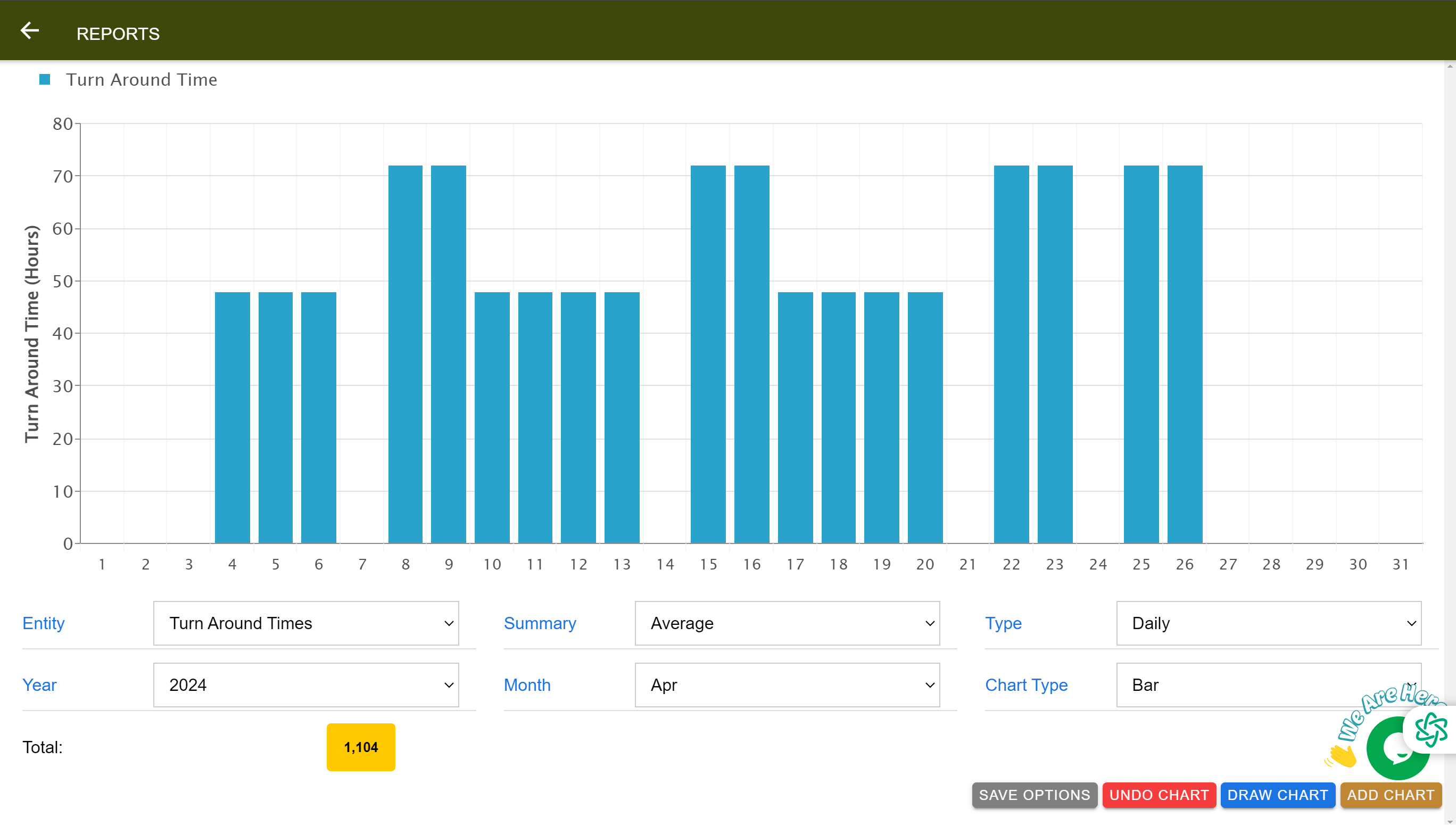
Task Management and Workflow Oversight
Task management is built into the system to help supervisors coordinate daily lab activities. Using a kanban-style task board, managers can assign responsibilities to staff, prioritize urgent actions, and track the progress of specific tasks such as test validation, equipment maintenance, or report sign-off. This helps keep teams organized, reduces miscommunication, and ensures that nothing falls through the cracks—especially in busy labs.
Conclusion
The Perfect Laboratory Manager is more than just a LIMS—it's an end-to-end digital solution tailored for the realities of healthcare delivery in Africa and other emerging regions. With offline-first operation, over 300 prebuilt tests and panels, integration with hospital systems, comprehensive billing, customizable workflows, machine interfacing, and powerful patient and referrer portals, it meets the needs of both small clinics and multi-site diagnostic chains.
Whether you're focused on improving turnaround time, increasing revenue accuracy, or expanding your lab's reach, this system gives you the tools to scale with confidence while maintaining compliance, quality, and patient trust.







